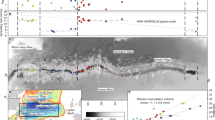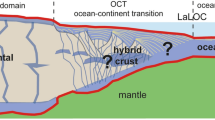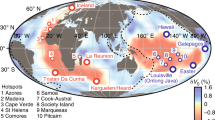Abstract
The origin of hotspot trails is controversial1. Explanations range from deep mantle plumes rising from the core–mantle boundary2 (CMB) to shallow plate cracking. However, these mechanisms cannot explain uniquely the scattered hotspot trails distributed across a 2,000-km-wide swell in the sea floor of the southeast Atlantic Ocean3. This swell projects down to one of the two largest and deepest distinct regions at the CMB, the Africa Low Shear Wave Velocity Province4,5,6. Here we use 40Ar/39Ar isotopic analyses to date lava samples erupted at several hotspot trails across the Atlantic swell. We combine the eruption ages with an analysis of the structure and age of the sea floor, and find that the trails formed synchronously, in a pattern consistent with movement of the African Plate over plumes rising from the edge of the Africa Low Shear Wave Velocity Province. However, we also find that the seamounts initially formed only at the edge of the swell, where the oceanic crust was spreading apart. Later, about 44 million years ago, the hotspot trails began to cross the swell, but only in locations where the lithosphere was sufficiently young and thin that magma could reach the surface. We conclude that the distribution of hotspot trails in the southeast Atlantic Ocean is controlled by the interplay between deep-sourced mantle plumes and the motion and structure of the African Plate.
This is a preview of subscription content, access via your institution
Access options
Subscribe to this journal
Receive 12 print issues and online access
$259.00 per year
only $21.58 per issue
Buy this article
- Purchase on Springer Link
- Instant access to full article PDF
Prices may be subject to local taxes which are calculated during checkout




Similar content being viewed by others
References
Courtillot, V., Davaille, A., Besse, J. & Stock, J. Three distinct types of hotspots in the Earth’s mantle. Earth Planet. Sci. Lett. 205, 295–308 (2003).
Morgan, W. J. Convection plumes in the lower mantle. Nature 230, 42–43 (1971).
Nyblade, A. N. & Robinson, S. W. The African superswell. Geophys. Res. Lett. 21, 765–768 (1994).
Burke, K., Steinberger, B., Torsvik, T. H. & Smethurst, M. A. Plume generation zones at the margins of Large Low Shear Velocity Provinces on the core–mantle boundary. Earth Planet. Sci. Lett. 265, 49–60 (2008).
Torsvik, T. H., Burke, K., Steinberger, B., Webb, S. J. & Ashwal, L. D. Diamonds sampled by plumes from the core–mantle boundary. Nature 466, 352–355 (2010).
Steinberger, B. & Torsvik, T. H. A geodynamic model of plumes from the margins of Large Low Shear Velocity Provinces. Geochem. Geophys. Geosyst. 13, Q01W09 (2012).
Hartnady, C. J. H. & le Roex, A. P. Southern Ocean hotspot tracks and the Cenozoic absolute motion of the African, Antarctic, and South American plates. Earth Planet. Sci. Lett. 75, 245–257 (1985).
Le Roex, A., Class, C., O’Connor, J. & Jokat, W. Shona and discovery aseismic ridge systems, South Atlantic: Trace element evidence for enriched mantle sources. J. Petrol. 51, 2089–2120 (2010).
Sleep, N. H. Mantle plumes from top to bottom. Earth Sci. Rev. 77, 231–271 (2006).
Crough, S. T. Hotspot Swells. Ann. Rev. Earth Planet. Sci. 11, 165–193 (1983).
McNutt, M. The Darwin Rise: A Cretaceous Superswell? Geophys. Res. Lett. 17, 1101–1104 (1990).
Class, C. & le Roex, A. South Atlantic DUPAL anomaly—dynamic and compositional evidence against a recent shallow origin. Earth Planet. Sci. Lett. 305, 92–102 (2011).
Class, C. & le Roex, A. P. Shona and Discovery seamount chains, South Atlantic: Superplume source constraints. Geochim. Cosmochim. Acta 73, A229 (2009).
Huang, S., Hall, P. S. & Jackson, M. G. Geochemical zoning of volcanic chains associated with Pacific hotspots. Nature Geosci. 4, 874–878 (2011).
O’Connor, J. M. & Duncan, R. A. Evolution of the Walvis Ridge–Rio Grande Rise hot spot system: Implications for African and South American plate motions over plumes. J. Geophys. Res. 95, 17475–17502 (1990).
O’Connor, J. M. & le Roex, A. P. South Atlantic hot spot–plume systems: 1. Distribution of volcanism in time and space. Earth Planet. Sci. Lett. 113, 343–364 (1992).
Richards, M. A., Duncan, R. A. & Courtillot, V. E. Flood basalts and hotspot tracks, Plume heads and tails. Science 246, 103–107 (1989).
Kent, R. W., Storey, M. & Saunders, A. D. Large igneous provinces: Sites of plume impact or plume incubation. Geology 20, 891–894 (1992).
White, R. S. & McKenzie, D. P. Magmatism at rift zones: The generation of volcanic continental margins and flood basalts. J. Geophys. Res. 94, 7685–7729 (1989).
O’Connor, J. M., Stoffers, P., van den Bogaard, P & McWilliams, M. First seamount age evidence for significantly slower African Plate motion since 19–30 Myr. Earth Planet. Sci. Lett. 171, 575–589 (1999).
Contreras-Reyes, E. et al. Crustal intrusion beneath the Louisville hotspot track. Earth Planet. Sci. Lett. 289, 323–333 (2010).
Burke, K. The African plate. S. Afr. J. Geol. 99, 339–410 (1996).
Ebinger, C. J. & Sleep, N. H. Cenozoic magmatism throughout east Africa resulting from impact of a single plume. Nature 395, 788–791 (1998).
Kessling, S. Die Tiefenstruktur der Kruste des Discovery Seamounts und des südlichen Walfischrückens im Südatlantik. Diploma thesis, Friedrich Schiller Univ. Jena (2008).
Adam, C. et al. South Pacific hotspot swells dynamically supported by mantle flows. Geophys. Res. Lett. 37, L08302 (2010).
McNutt, M., Caress, D., Reynolds, J., Jordahl, K. & Duncan, R. Failure of plume theory to explain midplate volcanism in the Southern Austral Islands. Nature 389, 479–482 (1997).
Sleep, N. H. Ridge-crossing mantle plumes and gaps in tracks. Geochem. Geophys. Geosyst. 3, 8505 (2002).
Renne, P. A., Glen, J. M., Milner, S. C. & Duncan, A. R. Age of Etendeka flood volcanism and associated intrusions in southwestern Africa. Geology 24, 659–662 (1996).
Müller, R. D., Roest, W. R. & Royer, J. Asymmetric sea-floor spreading caused by ridge-plume interactions. Nature 396, 455–459 (1998).
Sun, D., Helmberger, D. & Gurnis, M. A narrow, mid-mantle plume below southern Africa. Geophys. Res. Lett. 37, L09302 (2010).
Acknowledgements
We gratefully acknowledge the help during the RV Polarstern Expedition ANT XXIII/5 of Captain S. Schwarze, First Officer S. Spielke, their crew and P. le Roux, J. Hanley, D. Long, A. Nakashole and C. Tinguely and other members of the scientific party. N. Sleep provided valuable comments on the manuscript. Financial support was provided by the German Bundesministerium für Bildung und Forschung (BMBF), the Dutch Science Foundation (NWO), the South African National Research Foundation and the iKaba yAfrika project (A.P.l.R.) and by US National Science Foundation grant OCE07-38437 (C.C.).
Author information
Authors and Affiliations
Contributions
W.J., J.M.O., A.P.l.R. and C.C. conceived the project and secured financial support. J.M.O. wrote the paper with W.J., A.P.l.R., C.C. and S.K. Chief Scientist W.J. and J.M.O. carried out geophysics and sampling during the RV Polarstern cruise ANT-XXIII/5. O.N. and J.M.O. prepared the samples and J.R.W., K.F.K. and J.M.O. carried out the analytical work.
Corresponding author
Ethics declarations
Competing interests
The authors declare no competing financial interests.
Supplementary information
Supplementary Information
Supplementary Information (PDF 1731 kb)
Supplementary Information
Supplementary Information (ZIP 2398 kb)
Rights and permissions
About this article
Cite this article
O’Connor, J., Jokat, W., le Roex, A. et al. Hotspot trails in the South Atlantic controlled by plume and plate tectonic processes. Nature Geosci 5, 735–738 (2012). https://doi.org/10.1038/ngeo1583
Received:
Accepted:
Published:
Issue Date:
DOI: https://doi.org/10.1038/ngeo1583
This article is cited by
-
Evidence for compositionally distinct upper mantle plumelets since the early history of the Tristan-Gough hotspot
Nature Communications (2023)
-
The involvement of deep plume-related materials in the South Atlantic Ocean asthenosphere as indicated by isotopic independent component analysis of basalts
International Journal of Earth Sciences (2023)
-
Continental tapering of South America caused asymmetric non-uniform opening of the South Atlantic Ocean
Communications Earth & Environment (2022)
-
Seafloor evidence for pre-shield volcanism above the Tristan da Cunha mantle plume
Nature Communications (2020)



